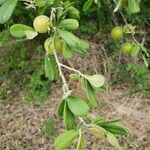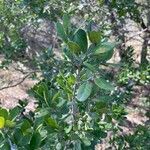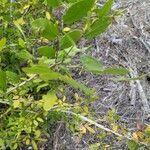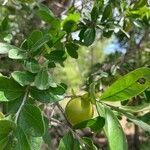A deciduous shrub or tree. It grows 8-12 m high. The trunk is short. It is 30 cm across. The crown is narrow. The leaves are rounded or oblong and leathery. They are 2-4 cm long by 10-19 mm wide. They are rounded or have a notch at the tip and taper to the base. They are widest above the middle. They are dull green above and paler underneath. The flowers are white and fragrant. They are bell shaped and 6 mm long and wide. Male and female flowers are on separate trees. There are 1-3 male flowers together and female flowers occur singly. The fruit are cherry-like and yellow to red or black. They are 19 mm wide and have a black, juicy, sweet pulp. There are 3-8 seeds.









